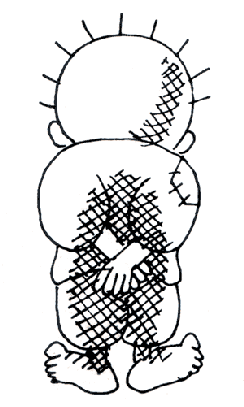Handala (Arabic: حنظلة, romanized: Ḥanẓala), also Handhala, Hanzala or Hanthala, is a prominent national symbol and personification of the Palestinian people.[1][2]
| Handala | |
|---|---|
 Handala, the Palestinian defiance symbol | |
| First appearance |
|
| Last appearance | 1987 |
| Created by | Naji al-Ali |
| In-universe information | |
| Full name | حنظلة |
| Gender | Male |
| Occupation | 10 year old child |
| Affiliation | Justice, steadfastness (see sumud), poverty |
| Origin | Palestinian refugee |
| Nationality | Palestinian |
The character was created in 1969 by political cartoonist Naji al-Ali, and first took its current form in 1973. Handala became the signature of Naji al-Ali's cartoons and remains an iconic symbol of Palestinian identity and defiance. The character has been described as "portraying war, resistance, and the Palestinian identity with astounding clarity".[3]
The name comes from the Arabic word for the colocynth (Arabic: حنظل, romanized: ḥanẓal), a perennial plant native to the Levant which bears bitter fruit, grows back when cut, and has deep roots.[4]
Handala's impact has continued in the decades after al-Ali's 1987 assassination; today the character remains widely popular as a representative of the Palestinian people, and is found on numerous walls and buildings throughout the West Bank (notably as West Bank Wall graffiti art), Gaza and other Palestinian refugee camps, and as a popular tattoo and jewellery motif. It has also been used by movements such as Boycott, Divestment and Sanctions and the Iranian Green Movement.[4]
Early publication
Handala appeared for the first time in Al-Seyassah in Kuwait on 13 July 1969,[1] and first turned his back to the viewer and clasped his hands behind his back from 1973 onwards.[5]
Symbolism
Handala's age – ten years old – represents Naji al-Ali's age in 1948 when he was forced to leave Palestine and would not grow up until he could return to his homeland:[6] Al-Ali wrote that:
Handala was born 10 years old and he will always be 10 years old. It was at that age that I left my homeland. When Handala returns, he will still be 10 years old, and then he will start growing up.
His posture, with his turned back and clasped hands, symbolises the character's "rejection at a time when solutions are presented to us the American way" and as "a symbol of rejection of all the present negative tides in our region."[4] His ragged clothes and standing barefoot symbolise his allegiance to the poor.[4] Al-Ali described Handala as "the symbol of a just cause":
He was the arrow of the compass, pointing steadily towards Palestine. Not just Palestine in geographical terms, but Palestine in its humanitarian sense—the symbol of a just cause, whether it is located in Egypt, Vietnam or South Africa.[6]
Legacy

Al-Ali stated in an interview prior to his assassination that: "Handala, whom I created, will not end after I die. I hope that this is not an exaggeration when I say that I will continue to live in Handala, even after I die". Current usages of the Handala motif include:
- Graffiti on numerous walls, buildings and souvenir shops throughout the West Bank (notably West Bank Wall graffiti art), Gaza and other Palestinian refugee camps[4]
- A primary symbol of the Boycott, Divestment and Sanctions movement[4]
- A popular tattoo and jewellery motif[4]
- The web mascot of the Iranian Green Movement[7]
- In Israeli artwork, particular alongside the Israeli character Srulik[8]
Gallery
- Near Bethlehem
- Near Bethlehem
- With Vittorio Arrigoni, by Carlos Latuff in 2011
See also
Bibliography
- Singh, Ashutosh (1 October 2019). "Time and Waiting: The Fulcrum of Palestinian Identity". Arab Studies Quarterly. 41 (4). doi:10.13169/arabstudquar.41.4.0317. S2CID 214325563.
- Oweis, Fayeq (5 July 2009). "Handala and the Cartoons of Naji al-Ali: Political Cartoons in the Middle East".[self-published source?]
- Olin, Margaret (2019). "How Long Will Handala Wait? A Ten-Year-Old Barefoot Refugee Child on Palestinian Walls". Timescapes of Waiting. pp. 176–197. doi:10.1163/9789004407121_012. ISBN 978-90-04-40712-1. S2CID 203233320.
- Habashi, Janette (2017). "The Evolvement of National Identity: A Never-Ending Process". Political Socialization of Youth. pp. 151–175. doi:10.1057/978-1-137-47523-7_8. ISBN 978-1-137-47522-0.
- Gandolfo, K. Luisa (1 January 2010). "Representations of Conflict". Radical History Review. 2010 (106): 47–69. doi:10.1215/01636545-2009-020.
- Woźniak, Marta (2014). "Mirror, Mirror on the Wall: Polititcal Cartoons of the Arab Spring". Hemispheres. Studies on Cultures and Societies. 29 (2): 79–97.
References
Wikiwand in your browser!
Seamless Wikipedia browsing. On steroids.
Every time you click a link to Wikipedia, Wiktionary or Wikiquote in your browser's search results, it will show the modern Wikiwand interface.
Wikiwand extension is a five stars, simple, with minimum permission required to keep your browsing private, safe and transparent.




